How Donbass turned into the center of Russian metallurgy
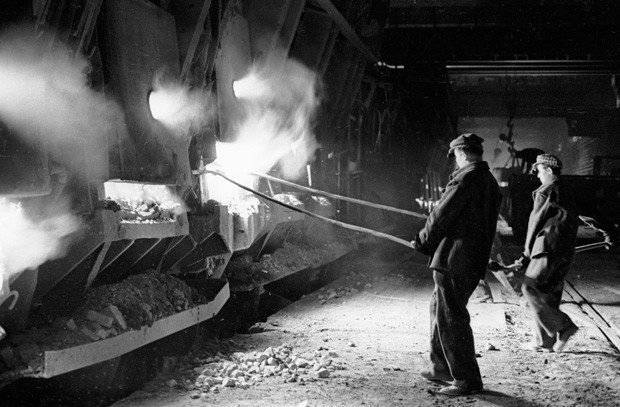
The first part of the publication was devoted to the chronic shortage of metals in Kievan and Moscow Rus. In the second part, we will talk about how in the 1917th century our country, thanks to the factories of the Urals, became the world's largest producer of metals. It was this powerful metallurgical base that was the basis of all the successes of the Russian Empire from Peter I to the Napoleonic wars. But by the middle of the XNUMXth century, Russia had lost the technological revolution in metallurgy, which predetermined its defeat in the Crimean War and the loss of Alaska. Until XNUMX, the country was never able to overcome this gap.
Ural iron
For a long time, the development of the Urals was hindered by its remoteness from the main cities and the small number of the Russian population. The first high-quality ore in the Urals was found back in 1628, when the “walking man” Timofey Durnitsyn and the blacksmith of the Nevyansk prison Bogdan Kolmogor discovered metal “veins” on the banks of the Nica River (the territory of the modern Sverdlovsk region).
Ore samples were sent "for testing" to Moscow, where they immediately assessed the quality of the Ural iron. By decree of the tsar, Ivan Shulgin, the “boyar son”, was sent from Tobolsk to the banks of the Nitsa, who began the construction of a metallurgical plant. Already in 1630, the first 63 pounds of pure iron were obtained in the Urals. Of these, 20 squeakers, 2 anchors and nails were made. Thus, the progenitor of the entire Ural industry arose.
However, until the end of the XVII century, the Urals still remained too distant and sparsely populated region. Only at the very end of this century, in 1696, Peter I ordered to start regular geological surveys of the Ural ore - “where exactly is the best magnet stone and good iron ore.”
Already in 1700, on the banks of the Neiva River (the source of the already mentioned Nitsa River), the Nevyansk Blast-Iron and Iron Works was built. The following year, a similar plant was built on the site of the modern city of Kamensk-Uralsky. In the 1704 year, in 150 miles to the north, the state-owned steel mill in Alapaevsk appears.
In 1723, the Yekaterinburg State Plant was built, which laid the foundation for the formation of the future industrial center of the Urals, the city of Yekaterinburg. At the plant that year, there were two blast furnaces that produced 88 poods of pig iron per year, and foundries that produced 32 poods of iron per year - that is, only one Ural plant produced as much iron as all of Russia produced a century ago, on the eve of the Troubled time." In total, 318 workers worked at the Yekaterinburg plant at the end of the reign of Peter I, of which 113 were employed directly in production, the rest in auxiliary work.
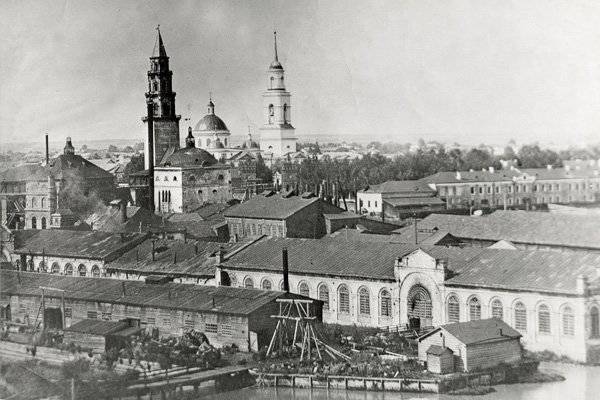
The Urals turned out to be an ideal place for a metallurgical base. By the beginning of the XNUMXth century, it was already sufficiently populated to provide labor for new factories. The Ural Mountains contained fairly close to the surface, rich deposits of high-quality ores - iron, copper and silver. Numerous full-flowing rivers made it relatively easy to use water as a driving force - this was required primarily for the operation of large blacksmith hammers and blast furnaces that forced air into blast furnaces for efficient melting.
Another important factor for development was the Urals forests, which made it possible to produce charcoal cheaply and in large quantities. The technologies of that time required for the smelting of one ton of iron to 40 cubic meters of wood, by special burning turned into charcoal.
Until the end of the 18th century, coal was not used in the production of metals, since, unlike wood, it contains considerable quantities of impurities, primarily phosphorus and sulfur, which completely killed the quality of the smelted metal. Therefore, the metallurgical production of that time required huge amounts of wood.
It was precisely the absence of a sufficient amount of wood of the necessary species that did not allow, for example, England at that time to establish its own mass production of metals. Ural with its dense forests was devoid of these shortcomings.
Therefore, only in the first 12 years of the 20th century, more than 24 new metallurgical plants appeared here. Most of them are located on the rivers Chusovaya, Iset, Tagil and Neiva. By the middle of the century, XNUMX more plants will be built here, which will turn the Urals into the largest metallurgical complex on the planet of that time in terms of the number of large enterprises, factory workers and metal smelting volumes.
In the XVIII century in the Urals around the metallurgical plants 38 new cities and settlements will arise. Taking into account factory workers, the urban population of the Urals will then be 14 – 16%, this is the highest urban density in Russia and one of the highest in the world of that century.
Already in 1750, Russia had 72 "iron" and 29 copper smelters. In the year they smelted 32 thousands of tons of pig iron (while UK factories only 21 thousand tons) and 800 tons of copper.
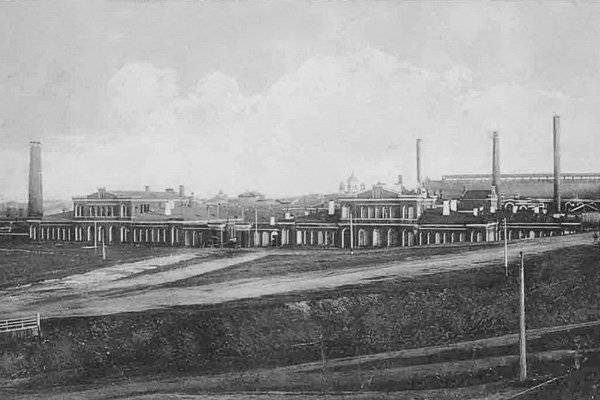
By the way, it was in the middle of the XNUMXth century in Russia, in connection with metallurgical production, which then required massive deforestation, that the first “environmental” law was adopted - the daughter of Peter I, Empress Elizabeth, issued a decree “to protect forests from extermination” to close all metallurgical manufactories within a radius of two hundred miles from Moscow and move them to the east.
Thanks to the construction begun by Peter I, the Urals became a key economic region of the country in just half a century. In the XVIII century, he produced 81% of all Russian iron and 95% of all copper in Russia. Thanks to the factories of the Urals, our country not only got rid of the centuries-old shortage of iron and expensive purchases of metals abroad, but also began to massively export Russian steel and copper to European countries.
Iron Age of Russia
The war with Sweden will deprive Russia of its previous supply of high-quality metal from this country and at the same time will require a lot of iron and copper for the army and fleet. But the new factories of the Urals will not only overcome the shortage of their own metal - already in 1714, Russia will begin to sell its iron abroad. That year, 13 tons of Russian iron were sold to England for the first time, in 1715 they sold 45 and a half tons, and in 1716 - 74 tons of Russian iron.
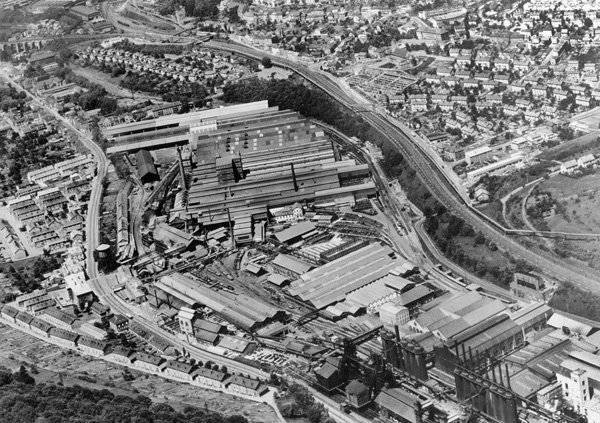
In 1715, the Dutch merchants, who had previously brought metal to Russia, removed 2846 pounds of “rod” Russian iron from Arkhangelsk. In 1716, for the first time, the export of metal from St. Petersburg began - in that year, the British ships took out the poods of iron from the new capital of the Russian Empire. Thus began the penetration of Russian metal into the European market.
Then the main source of iron and copper for Europe was Sweden. Initially, the Swedes were not too afraid of Russian competition, for example, in the 20 of the 18th century, in the largest English market in Europe, Swedish iron accounted for 76% of all sales, and Russian - only 2%.
However, as the Urals developed, the export of Russian iron grew continuously. During the 20s of the 590th century, it grew from 2540 to 40 tons annually. Sales of iron from Russia to Europe grew every decade, so in the 4s of the 5th century, on average, from 90 to 45 thousand tons per year were exported, and in the XNUMXs of the same century, Russian exports increased almost tenfold, to XNUMX thousand tons of metal annually.
Already in the 70s of the XNUMXth century, the volume of Russian iron supplies to England exceeded the Swedish ones. At the same time, the Swedes initially had great competitive advantages. Their metallurgical industry was much older than the Russian one, and the natural qualities of Swedish ores, especially in the Dannemura mines, famous throughout Europe, were higher than those of the Urals.
But the most important thing is that the richest mines in Sweden were located not far from the seaports, which made logistics much cheaper and cheaper. While the location of the Urals in the middle of the Eurasian continent turned the transportation of Russian metal into a very difficult task.
Mass transportation of metal could be provided exclusively by water transport. The barge, loaded with Ural iron, went on the voyage in April and only reached the Petersburg by the fall.
The path to Europe of Russian metal began in the tributaries of the Kama on the western slopes of the Urals. Further downstream, from Perm to the confluence of the Kama and the Volga, here began the hardest part of the journey - up to Rybinsk. The movement of river vessels against the current was provided by barge haulers. The cargo ship from Simbirsk to Rybinsk, they dragged a half or two months.
The “Mariinsky Water System” began from Rybinsk, and with the help of small rivers and artificial canals it connected the Volga basin with St. Petersburg via the White, Ladoga and Onega lakes. Petersburg at that time was not only the administrative capital, but also the main economic center of the country — Russia's largest port, through which the main flow of imports and exports passed.
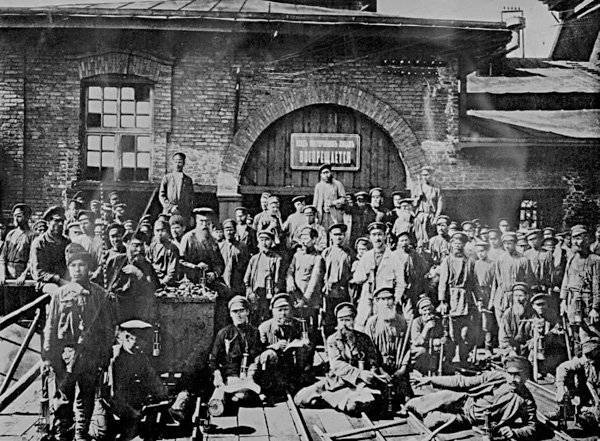
Despite such difficulties with logistics, Russian metal remained competitive in the foreign market. Selling prices for export "strip iron" in Russia in the 20-70s of the XVIII century were stable - from 60 to 80 kopecks per pood. By the end of the century, prices rose to 1 ruble 11 kopecks, but the ruble fell at that time, which again did not lead to significant changes in the foreign exchange prices for iron from Russia.
At that time, more than 80% of Russian export iron was bought by the British. However, from the middle of the 1600th century, deliveries of Russian metal to France and Italy began. On the eve of the French Revolution, Paris annually bought an average of 800 tons of iron from Russia. At the same time, about XNUMX tons of iron per year were exported from St. Petersburg to Italy, by ships around the whole of Europe.
In 1782, only iron exports from Russia reached 60 thousand tons, yielding revenues in excess of 5 million rubles. Together with revenues from exports to the East and West of Russian copper and Russian metal products, this gave a fifth of the total value of our country's total exports that year.
During the 18th century, copper production in Russia grew by more than 30 times. The closest global competitor in copper production — Sweden — by the end of the century was three times behind our country in terms of production.
Two thirds of the copper produced in Russia went to the treasury - this metal was particularly important in military production. The remaining third went to the domestic market and for export. Most of the Russian copper exports then went to France - for example, in the 60 of the 18th century, French merchants exported over 100 tons of copper from the Petersburg port every year.
For most of the 18th century, Russia was the largest metal producer on our planet and its leading exporter in Europe. For the first time, our country supplied to the external market not only raw materials, but also significant volumes of products of a complex, high-tech for the era of production.
As of 1769, there were 159 iron and copper smelters in Russia. At that time, the largest blast furnaces in the world were created in the Urals, up to 13 meters high and 4 meters in diameter with powerful blowers driven by a water wheel. By the end of the 90th century, the average productivity of the Ural blast furnace reached XNUMX thousand pounds of pig iron per year, which was one and a half times higher than the most modern blast furnaces in England at that time.
It was this developed metallurgical base that ensured the unprecedented rise in power and political significance of the Russian Empire in the 60th century. True, these achievements were based on serf labor - according to the lists of the Berg Collegium (created by Peter I, the highest body of the empire for the management of the mining industry), over XNUMX% of all workers at metallurgical plants in Russia were serfs, "assigned" and "purchased" peasants - that is, forced people , which were “assigned” to the factories by royal decrees, or bought for work by the factory administration.
End of the Russian Iron Age
At the very beginning of the 12th century, Russia was still the world leader in the production of metals. The Urals annually produced about 11 million poods of pig iron, while the closest competitors, the metallurgical plants of England, smelted no more than XNUMX million poods per year. The abundance of metal, as a base for military production, was one of the reasons that Russia not only survived, but also won during the Napoleonic wars.
However, it was at the beginning of the 19th century that the real technological revolution took place in metallurgy, which Russia, unlike successful wars, lost. As already mentioned, previously all metal was smelted solely on charcoal, the existing technologies did not allow obtaining high-quality iron using coal.
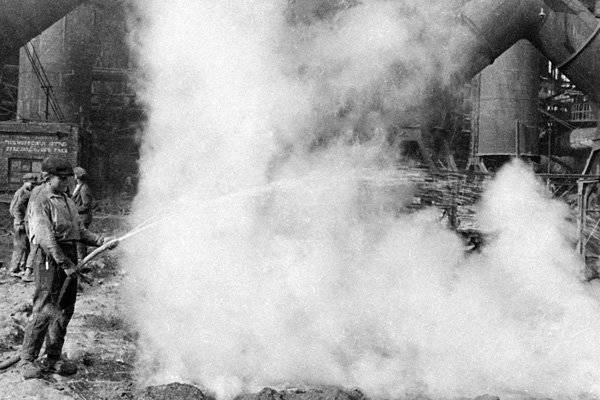
The first more or less successful experiments with the smelting of iron on coal took place in England at the beginning of the XNUMXth century. The British Isles did not have enough of their own forest as a raw material for charcoal, but there was an abundance of coal. The search for the right technology for smelting high-quality metal on coal took almost the entire XNUMXth century and was crowned with success by the beginning of the next century.
And this gave an explosive growth in the production of metals in England. Forty years after the end of the Napoleonic wars, Russia increased the production of metals by less than two times, while England during the same time increased the smelting of pig iron by 24 times - if in 1860 Russian production barely reached 18 million poods of pig iron, then in the British Isles during that in the same year they produced 13 times more, 240 million poods.
It cannot be said that during this period the industrial technologies of serf Russia stood still. There were some achievements. In the same months, when in St. Petersburg the guards officers were preparing the performance of the "Decembrists", not far away in Petrozavodsk, at the Alexander State Plant, the first rolling mills for iron smelting (the first in Russia and one of the first in the world) were being prepared for launch.
In 1836, only a few years behind the advanced technologies of England, at the Vyksa metallurgical plant in the Nizhny Novgorod province, the first experiments of “hot blast” were carried out - when pre-heated air is pumped into the blast furnace, which significantly saves coal consumption. In the same year, the first puddling experiments in Russia were carried out at the Ural plants - if earlier ore was smelted mixed with coal, then using the new puddling technology, cast iron was obtained in a special furnace without contact with fuel. It is curious that the very principle of such metal smelting for the first time in stories humanity was described in China two centuries before our era, and was rediscovered in England at the end of the eighteenth century.
Already in 1857, exactly one year after the invention of this technology in England, in the Urals, specialists from the Vsevolodo-Vilvensky plant conducted the first experiments of the “Bessemer” method of producing steel from cast iron by blowing compressed air through it. In 1859, Russian engineer Vasily Pyatov designed the world's first armor rolling mill. Before that, thick armor plates were obtained by forging thinner ones together, and Pyatov's technology made it possible to obtain whole armor plates of higher quality.
However, individual successes did not compensate for the system lag. By the middle of the 19th century, all metallurgy in Russia was still based on serf labor and charcoal. It is significant that even the armored rolling mill, invented in Russia, for several years was widely introduced into the industry of Britain, and at home remained for a long time experimental production.
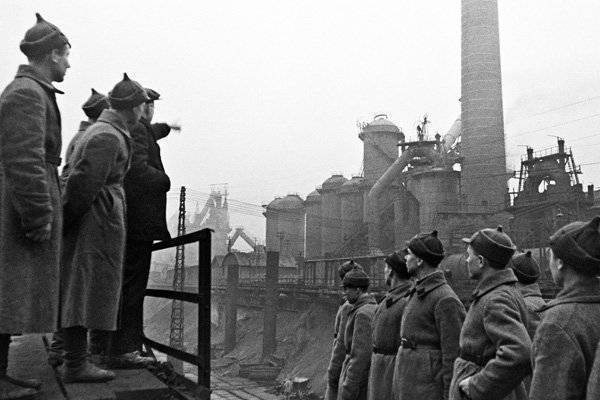
By 1850, a little more than 4 kilograms of pig iron was produced in Russia per capita, while in France over 11 kilograms, and in England over 18 kilograms. Such a backlog of the metallurgical base also predetermined the military-economic backwardness of Russia, in particular, it did not allow timely transition to the steam fleet, which in turn led to the defeat of our country in the Crimean War. In 1855-56, numerous British and French steamships dominated the Baltic, the Black and Azov Seas.
From the middle of the 70th century, Russia again turned from an exporter of metal into its buyer. If in the 80s of the 1800th century up to 30% of Russian iron was exported, then in 25 only 20% of the produced iron was exported, in the second decade of the 7th century - no more than XNUMX%. At the beginning of the reign of Emperor Nicholas I, the country already exported less than XNUMX% of the produced metal, and by the end of the reign, exports decreased to XNUMX%.
The mass railway construction that began at that time again gave rise to the shortage of iron in the country, forgotten for a century and a half. Russian factories could no longer cope with the increased demand for metal. If in 1851 Russia bought abroad 31680 tons of cast iron, iron and steel, then over the next 15 years, such imports increased by almost 10 times, reaching 1867 thousand tons in 312. By 1881, when the "Narodnaya Volya" killed Tsar Alexander II, the Russian Empire was buying 470 tons of metal from abroad. Over three decades, imports of pig iron, iron and steel from abroad increased 15 times.
It is significant that out of 11362481 rubles, 94 kopecks received by the tsarist government from the United States for the sale of Alaska, 10972238 rubles, 4 kopecks (that is, 97%) was spent on the purchase of equipment abroad for railways being built in Russia, primarily, a huge amount of rails and other metal products. . Money for Alaska was spent on imported rails for two railways from Moscow to Kyiv and from Moscow to Tambov.
In the 60-80 years of the XIX century, almost 60% of the metal consumed in the country was bought abroad. The reason was already blatant technological backwardness of the Russian metallurgy.
Until the last decade of the XIX century, two thirds of the pig iron in Russia was still produced on charcoal. Only by 1900, the amount of pig iron smelted from coal will exceed the amount obtained from the monstrous mass of the burned wood.
Very slowly, in contrast to the Western European countries of those years, new technologies were introduced. So, in 1885, out of 195 blast furnaces in Russia, 88 were still cold-blasted, that is, using the technology of the early 1900th century. But even in 10, such furnaces, with almost a century of delay in the technological process, still accounted for XNUMX% of the blast furnaces of the Russian Empire.
In 1870, 425 of new “puddling” furnaces and 924 of “hot hearth” on the old technology of the beginning of the century worked in the country. And only by the end of the 19th century, the number of “puddling” furnaces would exceed the number of “flashy horns” created by the hands of serf workers.
Donbass instead of the Urals
From the time of Peter the Great, for almost a century and a half, the Urals remained the main center of production of Russian metal. But by the beginning of the 20th century, at the other end of the empire, he had a powerful competitor, thanks to which Russia was able to at least partially overcome the lag behind the metallurgy of Western countries.
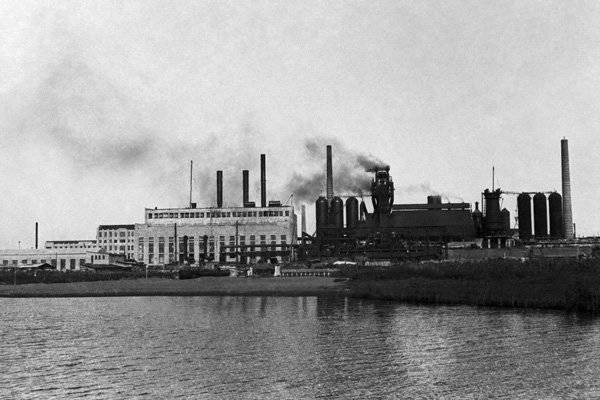
If the industry of the Urals was based on charcoal, then a new industrial area originally originated on deposits of coal. Surprisingly, Tsar Peter I also became an ancestor here. Returning from the first Azov campaign in 1696, he inspected samples of a well-burning black stone near the modern city of Shakhty near the borders of Donbass.
"This mineral, if not to us, then to our descendants, will be very useful to ours," the words of the tsar-reformer saved the documents. Already in 1721, on the orders of Peter I of Kostroma, the peasant Grigory Kapustin conducted the first search for coal deposits in the future Donbas.
However, they were able to master the first smelting of ore with coal and begin to populate the steppes of the Sea of \u1795b\uXNUMXbAzov only by the end of the XNUMXth century. In XNUMX, Empress Catherine II signed a decree "On the establishment of a foundry in the Donetsk district near the Lugan River and on the establishment of the breaking of coal found in that country." This plant, the main task of which was the production of cast-iron cannons for the ships of the Black Sea Fleet, laid the foundation for the modern city of Lugansk.
Workers for the Lugansk plant came from Karelia, from the cannon and metallurgical manufactories of Petrozavodsk, and from the metallurgical plant founded by Peter I in Lipetsk (there for a century they cut down the surrounding forests for charcoal for the domain and the production became unprofitable). It was these IDPs that initiated the proletariat of the future of Donbass.
In April, the first coal mine in the history of Russia earned 1796 for the Lugansk plant. It was located in the gully Lysicheya and the village of miners eventually became the city of Lysychansk. In 1799, under the direction of the masters hired in England, the first in Russia experienced metal smelting of local coal from local ore began at the Lugansk plant.
The problem of the plant was a very high production cost compared to the old Ural fortress factories. Only the high quality of the melted metal and the need to supply the Black Sea Fleet with guns and cores saved the plant from closing.
The second birth of the Donetsk industrial center of Russia began in the 60s of the XIX century, when, in addition to military products, a mass of steel rails was required for the construction of railways. It is curious that the economic calculations and geological surveys of coal and ore for future factories in the Donbass were then made by Apollon Mevius, a mining engineer from Tomsk, on his father's side he came from the descendants of Martin Luther, the founder of European Protestantism, who moved to Russia, and on his mother's side, from Siberian Cossacks - dissenters.
At the very end of the 60s of the XIX century, the right to build industrial enterprises in the Donbass (then it was part of the Yekaterinoslav province) was received by a friend of Tsar Alexander II, Prince Sergei Kochubey, a descendant of the Crimean Murza, who once defected to the Zaporizhzhya Cossacks. But the Russian prince of Cossack-Tatar origin was most fond of sea yachts, and in order not to waste time on boring construction work, in 1869 he sold all the rights received from the Russian government for the construction and development of mineral resources to the British Welsh industrialist John James Hughes.
John Hughes (or as he was called in Russian documents of those years - Hughes) was not only a capitalist, but also an inventor-engineer who got rich on creating new models of artillery and ship armor for the British fleet. In 1869, an Englishman ventured to buy the rights to build a metallurgical plant in the then undeveloped and sparsely populated New Russia. I took a risk and did not lose.
Jorn Hughes Corporation was called the Novorossiysk Society of Coal, Iron and Rail Production. In less than three years, in 1872, a new plant, built next to rich coal deposits near the village of Aleksandrovka, smelted the first batch of pig iron. The village is quickly turning into the working settlement of Yuzovka, named after the British owner. From this village, the modern city of Donetsk leads its pedigree.
Following the plants in the future Donetsk, two huge metallurgical productions appear in Mariupol. One plant was built by engineers from the USA and belonged to the Nikopol-Mariupol Mining and Metallurgical Society, controlled by French, German and American capital. However, according to rumors, the then all-powerful Minister of Finance of the Russian Empire, Count Witte, also had his financial interest in this enterprise. The second of the metallurgical giants under construction in Mariupol of those years belonged to the Belgian company Providence.
In contrast to the old factories of the Urals, the new metallurgical productions of Donbass were originally built as very large by the standards of that time, with the most modern, equipment purchased abroad. The commissioning of these giants almost immediately changed the whole picture of Russian metallurgy.
The production of cast iron and iron for the years 1895-1900 doubled throughout the country as a whole, while in Novorossia it almost quadrupled over these 5 years. Donbass rapidly replaced the Urals as the main metallurgical center - if in the 70s of the XIX century the Ural plants produced 67% of all Russian metal, and the Donetsk only 0,1% (one tenth of a percent), then by 1900 the share of the Urals in metal production had decreased to 28%, and the share of Donbass reached 51%.
Non-Russian Russian metal
On the eve of the 20th century, Donbass produced over half of the total metal of the Russian Empire. Production growth was significant, but still lagged behind leading European countries. So by the end of the XIX century, Russia produced 17 kilograms of metals per capita per year, while Germany - 101 kilograms, and England - 142 kilograms.
With the richest natural resources, Russia then gave only 5,5% of the world pig iron production. In 1897, the Russian factories produced 112 million poods of it, and almost 52 million poods were bought abroad.
True, in that year our country was the world leader in terms of production and export of manganese ores, which are necessary for the production of high-quality steel. In 1897, 22 million poods of this ore were mined in Russia, which accounted for almost half of the entire world production. Manganese ore was then mined in the Transcaucasus near the city of Chiatura in the very center of modern Georgia, and in the area of the city of Nikopol in the territory of the modern Dnepropetrovsk region.
However, by the beginning of the 292th century, the Russian Empire was seriously lagging behind in the production of copper, a very important metal for many military and civilian technologies of that time. Even at the beginning of the XNUMXth century, our country was one of the leading exporters of copper to Europe; in the first quarter of the century, XNUMX poods of Ural copper were sold abroad. At that time, the entire bronze industry of France worked on copper from the Urals.
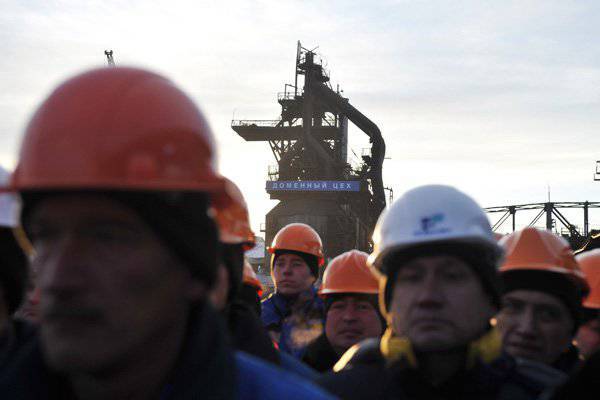
But by the end of the century, Russia itself had to buy imported copper, since the country produced only 2,3% of the global production of this metal. Over the last decade of the XIX century, the export of Russian copper amounted to less than 2 thousand pounds, while from abroad imported over 831 thousands of pounds of this metal.
The situation with the extraction of zinc and lead, equally important metals for the technologies of the beginning of the 20th century, was even worse. Despite the wealth of its own subsoil, their production in Russia then made hundredths of a percent in world production (zinc - 0,017%, lead - 0,05%), and all the needs of Russian industry were completely satisfied by imports.
The second defect of the Russian metallurgy was the ever-growing dominance of foreign capital. If in 1890, foreigners owned 58% of all capital in the metallurgical industry of Russia, then 1900, their share has grown to 70%.
It is no coincidence that at the dawn of the XNUMXth century, the second city in Russia after the capital Petersburg in terms of the number of foreign consulates was the county Mariupol - the modern industry that was rapidly developing in the Russian Empire was mostly owned by foreign capital, and Mariupol was not only one of the largest centers of metallurgy, but also the main trading port for a vast industrial region with factories and mines of Donbass.
In the first place among the foreign owners of Russian metal were the Belgians and the French (it was they who controlled, for example, the extraction of manganese ores in Russia), followed by the Germans, then the British. At the beginning of the 91th century, the Russian economist Pavel Ol' estimated that the share of foreign capital in the mining industry at that time was 42%, and in metal processing - XNUMX%.
For example, by 1907, 75% of all copper production in Russia was controlled by German banks through the Copper syndicate. On the eve of World War I, the situation only worsened - by 1914, German capital controlled 94% of Russian copper production.
But precisely because of the large foreign investments in 25 years before the First World War, the metallurgical and mining industry in Russia showed impressive growth - iron production grew almost 8 times, as well as coal production increased 8 times, and iron and steel production increased 7 times.
In 1913, the kilogram of iron in Russia was worth an average of 10-11 kopecks on the market. At current prices, this is about 120 rubles, at least twice as expensive as modern retail metal prices.
In 1913, Russian metallurgy ranked 4th on the planet and, in terms of key indicators, was approximately equal to French, but still lagged behind the most developed countries in the world. In that reference year, Russia smelted steel 6 times less than the United States, three times less than Germany and two times less than England. At the same time, the lion's share of the ore and almost half of the metal in Russia belonged to foreigners.
Information